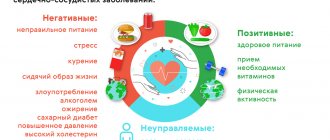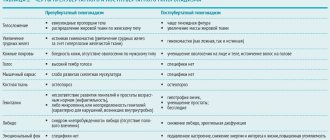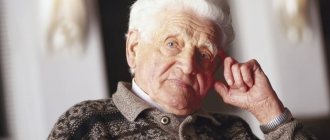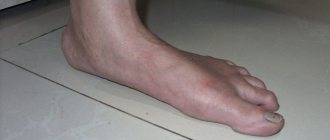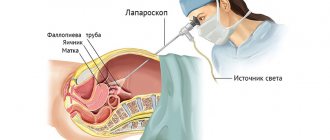Reasons for the blockade
The human heart beats as a result of electrical impulses that regulate the sequence and frequency of contractions of the chambers of the heart.
Electrical impulses are generated in the sinus node, a structure located in the upper chamber of the heart - the atrium. From the sinus node, impulses propagate down to the ventricles at a certain frequency, thereby setting the heart rate. If, for some reason, the impulses slow down or are blocked, a disease develops - heart block (atrioventricular block).
Heart block is a disease in which a person’s heart contracts with an abnormal frequency and rhythm due to disruption of the conduction system of the heart. As a result of blockades, arrhythmia or other, more serious diseases may develop.
Why does the disorder develop?
There are many different conditions that can disrupt the conduction of electrical impulses through the myocardium.
We cannot always accurately determine the cause of this phenomenon. Often we can only guess why the blockade occurred and try to slow down the progression of the process. In clinical cardiology, it is customary to distinguish two groups of cardiac conduction and excitability disorders:
- Cardiac, that is, caused by pathological processes occurring in the heart muscle. This may be coronary heart disease (CHD) or previous myocardial infarction, inflammatory diseases, cardiomyopathies. Often the source of the problem is congenital and acquired heart valve defects. Failure of the conduction system can be caused by tissue trauma during surgery.
- Non-cardiac - the cause of such disorders lies outside the myocardium. Most often we have to deal with endocrine diseases - diabetes and thyroid pathology. Among the possible causes, it is also worth highlighting hypertension, chronic bronchitis, asthma and other conditions leading to the development of hypoxia. In women, failure is often recorded during pregnancy, with the onset of menopause.
It is important to understand: the occurrence of blockade is not always associated with organic changes in the myocardium or serious non-cardiac diseases. Heart failure can be a temporary phenomenon due to stress or physical activity. The nature of the disorders can be determined by examining the patient.
Classification
There are several types of heart block. They are divided based on the location of the area where the conduction function of the heart is difficult or completely blocked. Due to the development of the disease in different parts of the heart, each blockade has its own characteristic features.
Photo: psodaz / freepik.com
Sinoatrial blockade
Sinoatrial block or sick sinus syndrome (SSNS) develops as a result of complete or partial dysfunction of the sinus node. This can occur both as a result of physiological disorders and due to other factors not related to the state of the body (extracardiac factors).
The main cause of SSSS can be considered fibrosis (development of connective tissue and its scarring) of the sinus node tissue. This pathology can be caused by inflammatory processes, increased tone of the vagal nerve, or taking medications.
SSSU can manifest itself:
- shortness of breath;
- general weakness of the body;
- pain in the heart;
- dizziness and loss of consciousness;
- low blood pressure;
- arrhythmia.
Interatrial block
Interatrial block develops when the propagation of electrical impulses is disrupted, both within and between the atria. The propagation of excitation occurs along special conduction pathways, which are circular and longitudinal muscle bundles, usually not described as part of the specialized conduction system of the heart.
One of the mechanisms of changes in the electrophysiological properties of the atrial myocardium, leading to a slowdown in conduction, is the development of fibrosis. There is a violation of the integrity of myocardial cells with the deposition of collagen in the intercellular space, which prevents the movement of impulses throughout the heart.
Accompanied by general weakness, pain in the chest and abnormal heart rate.
Atrioventricular block
Atrioventricular (AV) block is a partial or complete interruption of the transmission of impulses from the atria to the ventricles, leading to disturbances in heart rate and blood flow rate.
There are 3 types of atrioventricular block:
- 1st degree - due to a slow transition of impulses from the atria to the ventricles;
- 2nd degree - characterized by blocking of some impulses;
- 3rd degree - (complete atrioventricular block), associated with blocking of all impulses coming from the atria to the ventricles.
It occurs due to damage to the most sensitive area of the conduction system of the heart - the atrioventricular junction.
Intraventricular block
Intraventricular block occurs when the His bundle, the conducting region of the heart located in the region of the ventricles, is disrupted. The bundle of His consists of 3 branches: the left and right anterior branches and the posterior branch. The posterior branch is also divided into right and left.
Figure 1. Differences in ECG readings with normal rhythm and with blockades.
Intraventricular block is classified based on damage to 1 of 3 branches:
- Blocking of the anterior right branch - the innervation of the right ventricle is disrupted;
- Blocking of the anterior left branch - in case of disruption of the innervation of the left ventricle;
- Blocking of the posterior branch - the work of the His bundle is disrupted to the greatest extent, since along this branch impulses go from the atria to the ventricles, and are subsequently divided into right and left;
- Three-bundle block is associated with disruption of the conduction of the entire His bundle.
What you need to know about heart blocks
Cardiologist, Cardiology Department No. 2 Sherel N.V.
In order for the heart to provide blood to every cell of the body, it must contract in the correct rhythm and at a frequency of 55-60 to 80-90 beats per minute. The rhythm must be regular, with equal intervals between contractions, because the absence of oxygen carried in the blood, even for more than 30 seconds, can already affect the functioning of cells, and first of all, brain cells. The occurrence of oxygen starvation (hypoxia) of the brain is especially important for conditions such as heart block.
Heart block is a group of diseases characterized by a slowdown in the conduction of an electrical signal through the heart, resulting from congenital characteristics or, more often, diffuse replacement of normal cardiac muscle tissue with scar (connective) tissue. Basically, blockades lead to the development of bradycardia with a frequency of less than 50 per minute, but can also be combined with a rapid, irregular pulse, for example, with Frederick's syndrome - a combination of atrial fibrillation and complete atrioventricular block. The danger of complete blockades is that the absence of electrical excitation of the ventricles leads to the absence of their contraction in a time interval from several milliseconds to several minutes, which is fraught with the development of brain hypoxia, loss of consciousness and clinical death.
The development of blockades in a particular disease is explained by the fact that parts of the conduction system of the heart are often involved in the pathological process. These are modified muscle cells whose main task is to conduct an electrical signal so that a wave of excitation regularly passes throughout the heart. If these cells become inflamed, become enmeshed in scar tissue, or are unable to transmit impulses to downstream cells, a block occurs in the path of impulse transmission.
Depending on which part of the cardiac conduction system is involved in the pathological process, the following types of blockade are distinguished:
- sinoauricular (sinoatrial) – when the sinus node in the right atrium is blocked,
- intraatrial blockade - when the path of the electrical impulse along the walls of the atria is disrupted,
- atrioventricular - when a node is blocked that “switches” excitation from the atria to the ventricles,
- intraventricular block, or blockade of the right and left legs of His.
I degree blockades and incomplete His blockade, which are not clinically manifested, may be a variant of the norm or occur in athletes, in persons with vegetative-vascular dystonia, as well as in children, adolescents and young people with mitral valve prolapse, patent oval window and other small abnormalities of heart development.
Blockades of the 2nd and 3rd degrees, complete intraventricular blocks, three-bundle block (of both the right and both branches of the left leg of His) almost always occur with organic damage to the heart tissue. Diseases that cause inflammatory or scarring processes in the myocardium include:
1. Myocarditis – inflammation of the heart muscle caused by:
- viral infections - Coxsackie viruses, rubella, measles, Epstein-Barr (infectious mononucleosis), influenza, adenovirus, cytomegalovirus
- bacterial and parasitic infections - rheumatic fever, diphtheria, scarlet fever, toxoplasmosis, systemic chlamydia
- autoimmune diseases - rheumatoid arthritis (5 - 25% of patients have heart damage), systemic lupus erythematosus (5 - 15%), systemic scleroderma (20 - 40%)
2. Cardiomyopathies are a group of diseases with pathological changes in the normal anatomical structure of the heart (significant thickening of the walls of the heart or, conversely, their thinning with expansion of the internal cavities of the heart, preventing them from contracting and relaxing normally). They can develop with coronary heart disease, arterial hypertension, hormone imbalance in the body, the toxic effects of alcohol, drugs, metabolic disorders, myocarditis.
3. Cardiosclerosis – scarring of muscle tissue involved in the area of inflammation or in the area of necrosis (death) of the myocardium after myocardial infarction.
5. Acute myocardial infarction – 15% of patients experience conduction disturbances.
6. Congenital and acquired heart defects.
7. Intoxication with cardiac glycosides, beta blockers that slow down the heart rate.
8. Arterial hypertension often causes conduction disturbances within the atria of the heart.
Symptoms of heart block
First-degree blockades, incomplete single-bundle block of His legs, intraatrial blockade, as a rule, do not manifest themselves clinically and can only be detected by ECG during a routine examination.
Complete blockades are manifested by symptoms of arrhythmia and signs of the underlying disease. These clinical manifestations can occur suddenly, against the background of good health, or they can exist for a long time, with periods of deterioration, to which the patient has adapted and “learned” not to pay attention to them. However, if you notice some of these symptoms, you should consult a doctor for examination, because some symptoms may be a sign of impending dangerous conditions.
Symptoms of rhythm disturbance:
- weakness, increased fatigue, decreased ability to perform previous physical work,
- a feeling of interruptions in the work of the heart - a feeling of fading or cardiac arrest, discomfort in the chest,
- dizziness, flickering of spots before the eyes, sudden general weakness with a feeling of lightheadedness, tinnitus,
- Morgagni-Edems-Stokes attacks (MES attacks) - sudden sharp pallor, cold sticky sweat, thready rare pulse, loss of consciousness, possible convulsions due to cerebral hypoxia. As a rule, after a few seconds or two to three minutes consciousness is restored, but if this does not happen, and breathing and heartbeat are absent, it means that cardiac asystole (stop) and clinical death have developed,
- complete left His bundle blockade, which developed suddenly for the first time in life, can lead to the development of acute left ventricular failure with pulmonary edema, which is characterized by suffocation, cough with foam-like sputum, bluish skin of the lips, face, fingers, and shock.
- standard ECG is the main informative method confirming the presence of a blockade. However, a single electrocardiogram cannot always “catch” the signs of a block, especially in the case of transient heart blocks.
- Daily ECG monitoring is informative during transient blockades, as it allows you to analyze heart rhythm and conductivity throughout the day, including at night.
Not all blockades require treatment. As a rule, treatment of the underlying disease and correction of electrolyte balance are required. Severe 2nd and 3rd degree AV blocks require a pacemaker
Degrees and their symptoms
Heart blocks are classified not only by the place of its development, but also by the degree of severity, which reflects the danger of the disease to human health and approaches to treating a particular stage of heart block. There are three main stages of heart block
First degree heart block
The first degree is the mildest form of manifestation. There is a delay of a fraction of a second in the time required for electrical impulses to travel through the atrioventricular junction. Complete blocking does not occur and the impulses reach the desired point.
First-degree heart block usually does not cause any noticeable symptoms and is diagnosed by examining other medical conditions in the person. Treatment may be limited to eliminating risk factors that affect heart health.
Second degree heart block
As the second degree develops, there is a series of increasing delays in the time it takes for the atrioventricular junction to conduct an impulse into the ventricles until the heart beat is missed. Partial blocking of impulses is possible.
The second degree is divided into 2 types:
- The first type of Mobitz. This is a less serious type of second-degree heart block. Characterized by slow conduction of impulses. May cause symptoms of mild dizziness and weakness. Usually does not require treatment.
- Mobitz's second type. Electrical signals reach the ventricles slowly or may be completely blocked. This type of heart block can often progress to third degree heart block. May cause symptoms of dizziness and fainting, accompanied by bradycardia. Requires medical consultation and full treatment.
Third degree heart block
Third degree heart block is the most dangerous degree for a person’s health and life and requires immediate medical attention. It is characterized by complete blocking of the transmission of electrical impulses from the atria to the ventricles due to the lack of communication between the atrioventricular junction and the ventricles.
In this case, the ventricles can partially take over the function of a pacemaker, but they are not able to ensure full functioning of the heart.
Third degree blocks can be congenital or acquired as a result of other heart diseases or injuries.
Symptoms include:
- shortness of breath;
- weakness;
- fainting conditions;
- chest pain;
- pale skin, spots;
- arrhythmia.
Many cases of third-degree congenital heart block are diagnosed during pregnancy because ultrasound scans can often determine whether the baby has bradycardia.
Important! If the diagnosis is missed during pregnancy, symptoms of third-degree congenital heart block usually do not appear until the baby is older and his heart is more developed.
Possible symptoms
Clinically, heart blocks are not always evident. With mild disorders, the patient may not have any complaints. A malfunction in the functioning of the heart is detected only on an electrocardiogram.
With progressive conduction disturbances, the following symptoms occur:
- causeless weakness;
- labored breathing;
- dyspnea;
- interruptions in heart function;
- heart rate slowdown;
- dizziness.
If several impulses in a row do not pass through the tissues of the heart, loss of consciousness is possible. Over time, the disease progresses, the patient's condition worsens, and such attacks occur more often.
Diagnostics
Diagnosis of heart block begins with an interview and physical examination of the patient. Medical history and family history are studied. The patient's symptoms and lifestyle are examined. Medicines that the patient may have taken are checked.
Testing is carried out using a Holter or event monitor - devices that track heart rhythm over a certain period of time.
Figure 2. Signs of heart block.
A Holter monitor is used to study the heart over 24 or 48 hours. Event monitor - for a month or more. They allow changes in heart rate to be recorded even if they do not occur frequently or predictably.
An implantable loop recorder, a small heartbeat recorder that is placed under the skin over the heart, may be used. Capable of analyzing heart function for up to 2 years.
Basic methods of studying the functioning of the heart are used, such as electrocardiography (ECG) and electrophysiological studies. To diagnose heart diseases of a child in the womb, the ultrasound method is used.
Holter monitor. Photo: yupachingping / freepik.com
Treatment approaches
When choosing a treatment regimen, we focus on the protocols adopted by the Ministry of Health and clinical recommendations of domestic and foreign communities. Treatment must be comprehensive and rational. It is necessary not only to remove the symptom, but also to eliminate the possible cause of the problem - and prevent the development of complications.
Moderate disturbances of intraatrial and intraventricular conduction do not require treatment. We suggest that the patient be regularly monitored by a cardiologist, monitor his well-being, and lead a healthy lifestyle. Drug therapy is prescribed for obvious clinical symptoms - the appearance of interruptions in heart function, shortness of breath, dizziness and other conditions that interfere with leading a normal lifestyle. If dangerous complications develop, surgical treatment is indicated.
Let us dwell in more detail on the treatment of AV block. The treatment regimen will depend on the severity of the patient's condition. If, after the diagnosis, the ECG reveals first-degree AV block, therapy is not indicated. It is recommended only to be monitored by a specialist - visits to the doctor at least once a year.
If second-degree AV block of the Mobitz type 1 is detected, treatment should be comprehensive. To stabilize the conduction system of the heart, antiarrhythmic drugs are prescribed. At the same time, treatment is carried out for the underlying disease that caused the heart failure. No specific therapy is provided here. We select medications based on the leading symptoms and concomitant diseases.
Mobitz 2nd degree AV block and complete heart block are reasons for surgical treatment. A pacemaker is being implanted. The device regulates the heart rhythm, ensures proper transmission of signals and uninterrupted functioning of the myocardium. A pacemaker may also be offered to a patient with Mobitz type 1 AV block if severe symptoms are present.
Emergency care is indicated for the development of MAS syndrome and complete heart block. The patient must be hospitalized in a hospital. Indirect cardiac massage is performed and medications are prescribed to maintain a stable rhythm. The installation of a pacemaker is shown.
Treatment
When diagnosing first-degree heart block and first-degree Mobitz block, treatment as such is not necessary. These types of blockades do not pose any serious danger. The doctor may advise you to lead a healthy and active lifestyle, with moderate physical activity, and give up bad habits such as smoking and drinking alcohol.
When diagnosing Mobitz block of the second type and block of the 3rd degree, the patient needs medical attention, since the lack of treatment can lead to death.
The main treatment method for these types of blockades is the installation of a pacemaker. This device is surgically placed near the heart and monitors the correct frequency and rate of generation of electrical impulses.
Pacemaker. Photo: PantherMediaSeller / Depositphotos
Doctor's advice: how to properly see a doctor if there is a blockage
After the diagnosis is established, the patient remains in outpatient treatment or is hospitalized in a hospital. Tactics are determined by the severity of the blockade. After achieving remission, the patient should not be left without specialist supervision. We recommend:
- If your condition is stable and there are no complaints, visit a cardiologist and do an ECG every 6 months.
- If the condition worsens, new complaints appear or existing disorders progress, make an appointment with a doctor as soon as possible.
If the doctor prescribes drug therapy, you should adhere to it and not violate the drug dosage schedule. Stopping the medication on your own is unacceptable - this leads to the development of complications.
If the patient has had a pacemaker installed, the monitoring tactics change. You should visit your doctor 3, 6 and 12 months after surgery to make sure that the device is working smoothly. The further observation schedule will depend on the patient’s condition.
Forecast
Heart block can be congenital) but most often develops after birth. In general, the risk of acquired heart block increases with age, as does the incidence of cardiovascular disease.
First-degree heart block is common in well-trained athletes, adolescents, young adults, and individuals with a highly active vagus nerve. People with various heart conditions, including coronary artery disease, rheumatic heart disease, sarcoidosis, or other structural heart disease, are also at risk of developing first-degree heart block.
Without proper treatment, second-degree Mobitz blocks and third-degree blocks can be accompanied by symptoms that significantly impair the quality of life: constant fatigue, chest pain, severe dizziness and fainting. Without treatment, complete cardiac arrest can result.
Lifestyle and precautions
Treatment and prevention of heart problems is not only about taking medications or undergoing surgery. We recommend that the patient completely change his attitude towards life. To prevent the progression of the disease and avoid undesirable consequences, you should:
- Change your diet. The daily menu should contain less fried, spicy and salty foods. It is recommended to add products of plant origin, focusing on fresh vegetables and fruits. Fast food and quickly digestible carbohydrates are prohibited - they negatively affect metabolism and provoke the development of cardiovascular pathology.
- Exercise. Aerobic exercise, yoga, and swimming are recommended. If it is not possible to visit a fitness club or gym, you can walk in the fresh air every day - at least 30 minutes a day.
- Don't overexert yourself. Working too hard will not be good for your heart. It's worth reconsidering your daily routine. Night sleep should be at least 8 hours.
- Avoid stress. Excessive worries negatively affect the functioning of all internal organs, and the heart is no exception.
- Watch your weight. If you are overweight or obese, you should consult an endocrinologist and create a diet.
- To refuse from bad habits. Smoking is prohibited. You should not abuse alcohol.
The prognosis of the disease depends on the severity of the patient's condition. Compliance with all doctor’s recommendations and timely installation of a pacemaker will prolong life and maintain health.
Case from practice
Patient R., 75 years old, turned to his local doctor with complaints of interruptions in his heart function.
Upon examination and history taking, it turned out that the patient was also bothered by headaches, attacks of dizziness, and shortness of breath during exercise and at rest. Considers himself sick for 10 years. Suffered a myocardial infarction at the age of 67 years. She is seen by a cardiologist with a diagnosis of coronary artery disease. Post-infarction cardiosclerosis. After further examination, ECG revealed signs of second degree AV block, and echoCG revealed left ventricular hypertrophy. After consultation with a cardiologist, the patient was referred to the cardiac surgery center. A pacemaker was installed. The patient was discharged with improved condition. Observation by a cardiologist is recommended.
